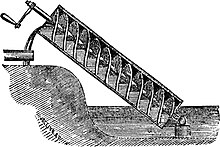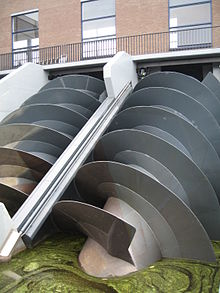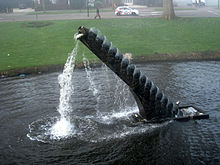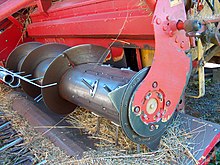Archimedes' screw






The Archimedes screw, also called the Archimedean screw or screwpump, is a machine historically used for transferring water from a low-lying body of water into irrigation ditches. Water is pumped by turning a screw-shaped surface inside a pipe.
The screw pump is commonly attributed to Archimedes on the occasion of his visit to Egypt. This tradition may reflect only that the apparatus was unknown to the Greeks before Hellenistic times and was introduced in Archimedes' lifetime by unknown Greek engineers.[1] Some writers have suggested the device may have been in use in Assyria some 350 years earlier.
Design
The Archimedes screw consists of a screw (a helical surface surrounding a central cylindrical shaft) inside a hollow pipe. The screw is turned usually by a windmill or by manual labour. As the shaft turns, the bottom end scoops up a volume of water. This water is then pushed up the tube by the rotating helicoid until finally it pours out from the top of the tube.
The contact surface between the screw and the pipe does not need to be perfectly watertight, as long as the amount of water being scooped with each turn is large compared to the amount of water leaking out of each section of the screw per turn. If water from one section leaks into the next lower one, it will be transferred upwards by the next segment of the screw.
In some designs, the screw is fused to the casing and they both rotate together, instead of the screw turning within a stationary casing. A screw could be sealed with pitch resin or other adhesive to its casing, or cast as a single piece in bronze. Some researchers have postulated this as being the device used to irrigate the Hanging Gardens of Babylon, one of the Seven Wonders of the Ancient World. Depictions of Greek and Roman water screws show them being powered by a human treading on the outer casing to turn the entire apparatus as one piece, which would require that the casing be rigidly attached to the screw.
The design of the everyday Greek and Roman water screw, in contrast to the heavy bronze device of Sennacherib, with its problematic drive chains, has a powerful simplicity. A double or triple helix was built of wood strips (or occasionally bronze sheeting) around a heavy wooden pole. A cylinder was built around the helices using long, narrow boards fastened to their periphery and waterproofed with pitch[2]
Uses
The screw was used predominately for transferring water to irrigation systems and for draining water out of mines or other areas of low-lying water. It was used for draining land that was underneath the sea in the Netherlands and other places in the creation of polders.
Archimedes screws are used in sewage treatment plants because they cope well with varying rates of flow and with suspended solids. An auger in a snow blower or grain elevator is essentially an Archimedes screw. Many forms of axial flow pump basically contain an Archimedes' screw.
The principle is also found in pescalators, which are Archimedes screws designed to lift fish safely from ponds and transport them to another location. This technology is used primarily at fish hatcheries, where it is desirable to minimize the physical handling of fish.
An Archimedes screw was used in the successful 2001 stabilization of the Leaning Tower of Pisa. Small amounts of subsoil saturated by groundwater were removed from far below the north side of the Tower, and the weight of the tower itself corrected the lean.
Archimedes screws are also used in chocolate fountains.
History
The invention of the water screw is credited to the Greek polymath Archimedes of Syracuse in the 3rd century BC.[1] A cuneiform inscription of the Assyrian king Sennacherib (704 - 681BC) has been interpreted by Stephanie Dalley[3] to describe the casting of water screws in bronze some 350 years earlier. This is consistent with the classical author Strabo who describes the Hanging Gardens as watered by screws. A contrary view is expressed by Dalley and Oleson in an earlier review.[2] The German engineer Konrad Kyeser, in his Bellifortis (1405), equips the Archimedes' screw with a crank mechanism. This mechanism soon replaced the ancient practice of working the pipe by treading.[4]
Variants

A screw conveyor is an Archimedes' screw contained within a tube and turned by a motor so as to deliver material from one end of the conveyor to the other. It is particularly suitable for transport of granular materials such as plastic granules used in injection molding, and cereal grains. It may also be used to transport liquids. In industrial control applications the conveyor may be used as a rotary feeder or variable rate feeder to deliver a measured rate or quantity of material into a process.
A variant of the Archimedes' screw can also be found in some injection molding machines, die casting machines and extrusion of plastics, which employ a screw of decreasing pitch to compress and melt the material. Finally, it is also used in a specific type of positive displacement air compressor: the rotary-screw air compressor. On a much larger scale, Archimedes' screws of decreasing pitch are used for the compaction of waste material.
Reverse action
If water is fed into the top of an Archimedes' screw, it will force the screw to rotate. The rotating shaft can then be used to drive an electric generator. Such an installation has the same benefits as using the screw for pumping: the ability to handle very dirty water and widely varying rates of flow at high efficiency. Settle Hydro and Torrs Hydro are two reverse screw micro hydro schemes operating in England. The screw is good as a generator at low heads, commonly found in English rivers, including the Thames powering Windsor Castle.[5][6]
See also
- Archimedes
- Archimedean spiral
- Screw-propelled vehicle
- SS Archimedes – the first steamship driven by a screw propeller.
- Screw (simple machine)
- Spiral pump
- Turbine
- Vitruvius
Footnotes
- ^ a b Oleson 2000, pp. 242–251
- ^ a b Dalley S and Oleson JP, (2003), "Sennacherib, Archimedes and the water screw: the context of invention in the ancient world" Technology and Culture 44
- ^ Stephanie Dalley, The Mystery of the Hanging Garden of Babylon: an elusive World Wonder traced, (2013), OUP ISBN 978-0-19-966226-5
- ^ White, Jr. 1962, pp. 105, 111, 168
- ^ Shankleman, Jessica. "Queen Elizabeth joins the hydropower revolution" BusinessGreen, 9 September 2011. Retrieved: 21 July 2012.
- ^ Shankleman, Jessica. "The Queen's hydro energy scheme slots into place" BusinessGreen, 21 December 2011. Retrieved: 21 July 2012.
Sources
- P. J. Kantert: "Manual for Archimedean Screw Pump", Hirthammer Verlag 2008, ISBN 978-3-88721-896-6.
- P. J. Kantert: "Praxishandbuch Schneckenpumpe", Hirthammer Verlag 2008, ISBN 978-3-88721-202-5.
- Oleson, John Peter (1984), Greek and Roman mechanical water-lifting devices. The History of a Technology, Dordrecht: D. Reidel, ISBN 90-277-1693-5
- Oleson, John Peter (2000), "Water-Lifting", in Wikander, Örjan (ed.), Handbook of Ancient Water Technology, Technology and Change in History, vol. 2, Leiden, pp. 217–302 (242–251), ISBN 90-04-11123-9
{{citation}}: CS1 maint: location missing publisher (link) - Nuernbergk, D. and Rorres C.: „An Analytical Model for the Water Inflow of an Archimedes Screw Used in Hydropower Generation", ASCE Journal of Hydraulic Engineering, Published: 23 July 2012
- Nuernbergk D. M.: "Wasserkraftschnecken – Berechnung und optimaler Entwurf von archimedischen Schnecken als Wasserkraftmaschine", Verlag Moritz Schäfer, Detmold, 1. Edition. 2012, 272 papes, ISBN 978-3-87696-136-1
- Rorres C.: "The turn of the Screw: Optimum design of an Archimedes Screw", ASCE Journal of Hydraulic Engineering, Volume 126, Number 1, Jan.2000, pp. 72–80
- Nagel, G.; Radlik, K.: Wasserförderschnecken – Planung, Bau und Betrieb von Wasserhebeanlagen; Udo Pfriemer Buchverlag in der Bauverlag GmbH, Wiesbaden, Berlin (1988)
- White, Jr., Lynn (1962), Medieval Technology and Social Change, Oxford: At the Clarendon Press
External links
- Technology and Culture Volume 44, Number 1, January 2003 (PDF) Dalley, Stephanie. Oleson, John Peter. "Sennacherib, Archimedes, and the Water Screw: The Context of Invention in the Ancient World"
- The Turn of the Screw: Optimal Design of an Archimedes Screw, by Chris Rorres, PhD.
- "Archimedean Screw" by Sándor Kabai, Wolfram Demonstrations Project, 2007.
